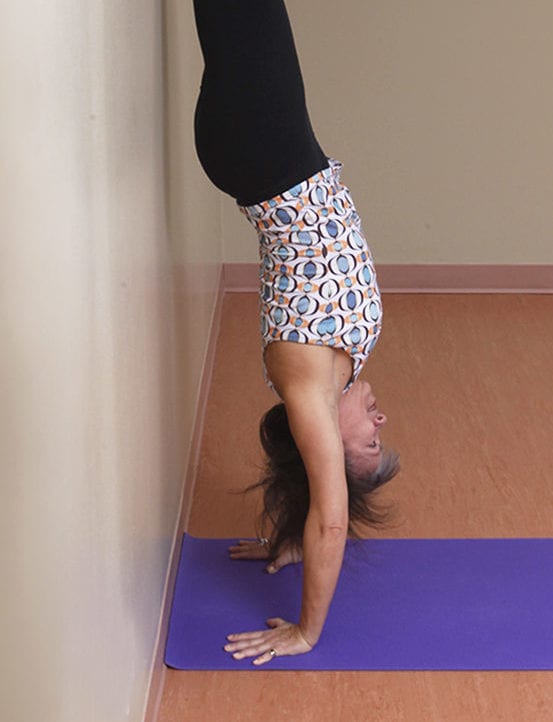We all know weightlifting is not just a young man’s sport. In fact, growing strong bones and muscles is a primary means for slowing down the aging process and heightening our immune systems.
In an earlier Free Press article (May 28, 2016), we stressed the importance of maintaining bone mass to avoid or eliminate osteoporosis. It is equally important to balance our strong bones with strong muscles, both of which allow us to safely carry our body weight through any number of physical activities.
In yoga, not unlike weightlifting, we use the asana (posture) practice to build muscle strength through repetitions with short holds. Yoga, unlike weightlifting, uses the body as the weight to lift. Try holding Virabhadrasana II (Warrior II) without strong supportive muscles around your joints. Once strength is acquired, the yogi gradually extends these shorter holds from one or two breaths into five or 10 breaths, which begins to create muscle length and joint space. Both of these qualities increase flexibility and thereby enhance mobility.
For practitioners with natural or even extreme flexibility, it is vital to strengthen the muscles surrounding their typically loose or even hyper-extended joints. Ball and socket joints, such as the shoulders and hips, are held in place by a variety of muscles.
The weaker the surrounding muscles are, the greater chance of joint dislocation due to excessive mobility. As you may already know, a dislocated limb is unable to lift or support weight.
Conversely, for yogis with excessively strong musculature and probably limited flexibility, poses such as Urdhva Dhanurasana (see below) become difficult or impossible. In these cases, the yogi lacks the muscle length that provides flexibility and the open joints that provide mobility, both of which allow them to straighten their arms and legs into the upward bow shape. In attempting to avoid all extremes, Buddhist teachings about the Middle Way encourage us away from “either” strength “or” flexibility toward “both/and.”
Yoga also emphasizes the marriage of these two extremes — stability (strength) and ease (flexibility) — as the balancing point for healthy interaction with oneself and the whole of life.
In order to further this quest for inner and outer balance, we use yoga actions to bring awareness into specific muscle, bone and energy pathways no matter what pose — downward dog, triangle, handstand, etc. — you wish to practice. The yoga actions described below bring consciousness and openness into energy pathways in the arms and legs for the purpose of balancing muscular-skeletal development.
Note: The poses below are for intermediate practitioners. Beginner variations of these poses can be found in our books (see below). The yoga actions are for all levels of practice.
Actions: From the outer edges of the shoulder blades, lengthen down the outer arms into the baby-finger mounds. From the webs of the thumb and index fingers, lengthen up the inner arms into the inner armpit. From the inner groins, lengthen down both inner legs into the inner heels. From the outer arches, lengthen up the outer legs into the outer hips.
For advanced practitioners: Complete the intermediate action in the arms and legs. For added stability, firm your arm and leg muscles to the bones and lengthen your spine.

VASISTHASANA with VRKSASANA (Side plank pose with tree) Begin in Adho Mukha Svanasana (downward-facing dog). Straighten your body into plank by extending out through your heels and guiding your shoulders over your wrists. Find the yoga actions in your arms and legs. Roll onto your right hand and outer edge of your right foot. Find the actions again. Lift your left foot into Vrksasana and raise your left arm. Hold for five to 10 breaths. Rest in plank or AMS between sides, then repeat to the left.

ADHO MUKHA VRKSASANA (Downward-facing tree pose or handstand) Begin in Adho Mukha Svanasana (downward-facing dog) facing the wall. Complete the actions in the arms and legs. Take a runner’s stride or walk your feet in slightly to kick up into the pose. Use our YouTube video for more specific instructions to kick up into Handstand. Once you are in the inversion, complete the actions again in the arms and legs. Stay for five to 10 breaths, then come down with control.

URDHVA DHANURASANA (Upward bow pose or wheel) Lie on your back with your knees bent, feet close to sit bones and hip-distance apart. Place your palms on the floor by your ears with fingertips pointing toward your feet. Find the yoga actions. Keeping your knees and elbows parallel, press into your palms and feet lifting your pelvis upward. Straighten your arms but keep a slight bend in your knees. Repeat the actions in your arms and legs. Hold for five to 10 breaths. Come down with control.
 By: Helen Maupin, Candace Propp and Stacy Schroder, originally published in the Winnipeg Free Press on 10/22/2016. Winnipeggers Helen Maupin and Candace Propp are 500-hour certified yoga teachers. Discover more actions for healthy muscles and bones in their book series — Creating Space: Yoga Actions for Feet & Ankles; Legs & Knees; Pelvis & Psoas; Torso & Spine; Shoulders & Arms. Helen offers yoga teacher training at Serene Yoga Studio. To purchase her books go to Products or for yoga teacher training with her, go to sereneyogastudio.com.
By: Helen Maupin, Candace Propp and Stacy Schroder, originally published in the Winnipeg Free Press on 10/22/2016. Winnipeggers Helen Maupin and Candace Propp are 500-hour certified yoga teachers. Discover more actions for healthy muscles and bones in their book series — Creating Space: Yoga Actions for Feet & Ankles; Legs & Knees; Pelvis & Psoas; Torso & Spine; Shoulders & Arms. Helen offers yoga teacher training at Serene Yoga Studio. To purchase her books go to Products or for yoga teacher training with her, go to sereneyogastudio.com.




